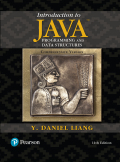
(Check order) Write the following overloaded methods that check whether an array is ordered in ascending order or descending order. By default, the method checks ascending order. To check descending order, pass false to the ascending argument in the method.
public static boolean ordered(int[] list)
public static boolean ordered(int[] list, boolean ascending)
public static boolean ordered(double[] list)
public static boolean ordered
(doublet[] list, boolean ascending)
public static <E extends Comparable<E>>
boolean ordered(E[] list)
public static <E extends Comparable<E>> boolean ordered
(E[] list, boolean ascending)
public static <E> boolean ordered(E[] list,
Comparator<? super E> comparator)
public static <E> boolean ordered(E[] list,
Comparator<? super E> comparator, boolean ascending)
Want to see the full answer?
Check out a sample textbook solution
Chapter 23 Solutions
Introduction to Java Programming and Data Structures Comprehensive Version (11th Edition)
Additional Engineering Textbook Solutions
Starting Out with Programming Logic and Design (5th Edition) (What's New in Computer Science)
Starting Out with Java: From Control Structures through Data Structures (4th Edition) (What's New in Computer Science)
Problem Solving with C++ (10th Edition)
Management Information Systems: Managing The Digital Firm (16th Edition)
SURVEY OF OPERATING SYSTEMS
Degarmo's Materials And Processes In Manufacturing
- 3.[20 pts] Find the minimum equivalent circuit for the one shown below (show your work): DAB 0 f(A,B,C,D)arrow_forwardSuppose your computer is responding very slowly to information requests from the Internet. You observe that your network gateway shows high levels of network activity even though you have closed your e-mail client, Web browser, and all other programs that access the Internet. What types of malwares could cause such symptoms? What steps can you take to check whether malware has gained access to your system? What tools can you use at each step? If you identify malware, what ways might it have entered your system? How can you restore your PC to safe operation, including the special software tools you may use?arrow_forwardR languagearrow_forward
- Using R languagearrow_forwardCompare the security services provided by a digital signature (DS) with those of a message authentication code (MAC). Assume that Oscar can observe all messages sent between Rina and Naseem. Oscar has no knowledge of any keys but the public one, in the case of DS. State whether DS and MAC protect against each attack and, if they do, how. The value auth(x) is computed with a DS or a MAC algorithm. In each scenario, assume the message M = x#####auth(x). (Message integrity) Rina has the textual data x = “Transfer $1000 to Mark” to send to Naseem. To ensure the integrity of the data, Rina generates auth(x), forms a message M, and then sends M in cleartext to Naseem. Oscar intercepts the message and replaces “Mark” with “Oscar.” Will Naseem detect this in the case of either DS or MAC? If yes, how will Naseem detect it? If not, why? (Replay) Rina has the textual data x = “Transfer $1000 to Mark” to send to Naseem. To ensure the integrity of the data, Rina generates auth(x), forms a message…arrow_forwardI need to resolve the following....You are trying to convince your boss that your company needs to invest in a license for MS-Project (project management software from Microsoft) before beginning a systems project. What arguments would you give her?arrow_forward
- What are the four types of feasibility? what is the issues addressed by each feasibility component.arrow_forwardI would like to get ab example of a situation where Agile Methods might be preferable versus the traditional SDLC? What are the characteristics of this situation that give Agile Methods an advantage?arrow_forwardWhat is a functional decomposition diagram? what is a good example of a high level task being broken down into tasks in at least two lower levels (three levels in all).arrow_forward
- What are the advantages to using a Sytems Analysis and Design model like the SDLC vs. other approaches?arrow_forward3. Problem Description: Define the Circle2D class that contains: Two double data fields named x and y that specify the center of the circle with get methods. • A data field radius with a get method. • A no-arg constructor that creates a default circle with (0, 0) for (x, y) and 1 for radius. • A constructor that creates a circle with the specified x, y, and radius. • A method getArea() that returns the area of the circle. • A method getPerimeter() that returns the perimeter of the circle. • • • A method contains(double x, double y) that returns true if the specified point (x, y) is inside this circle. See Figure (a). A method contains(Circle2D circle) that returns true if the specified circle is inside this circle. See Figure (b). A method overlaps (Circle2D circle) that returns true if the specified circle overlaps with this circle. See the figure below. р O со (a) (b) (c)< Figure (a) A point is inside the circle. (b) A circle is inside another circle. (c) A circle overlaps another…arrow_forward1. Explain in detail with examples each of the following fundamental security design principles: economy of mechanism, fail-safe default, complete mediation, open design, separation of privilege, least privilege, least common mechanism, psychological acceptability, isolation, encapsulation, modularity, layering, and least astonishment.arrow_forward
- Programming Logic & Design ComprehensiveComputer ScienceISBN:9781337669405Author:FARRELLPublisher:Cengage
 EBK JAVA PROGRAMMINGComputer ScienceISBN:9781337671385Author:FARRELLPublisher:CENGAGE LEARNING - CONSIGNMENT
EBK JAVA PROGRAMMINGComputer ScienceISBN:9781337671385Author:FARRELLPublisher:CENGAGE LEARNING - CONSIGNMENT C++ Programming: From Problem Analysis to Program...Computer ScienceISBN:9781337102087Author:D. S. MalikPublisher:Cengage Learning
C++ Programming: From Problem Analysis to Program...Computer ScienceISBN:9781337102087Author:D. S. MalikPublisher:Cengage Learning  Microsoft Visual C#Computer ScienceISBN:9781337102100Author:Joyce, Farrell.Publisher:Cengage Learning,
Microsoft Visual C#Computer ScienceISBN:9781337102100Author:Joyce, Farrell.Publisher:Cengage Learning, Programming with Microsoft Visual Basic 2017Computer ScienceISBN:9781337102124Author:Diane ZakPublisher:Cengage Learning
Programming with Microsoft Visual Basic 2017Computer ScienceISBN:9781337102124Author:Diane ZakPublisher:Cengage Learning C++ for Engineers and ScientistsComputer ScienceISBN:9781133187844Author:Bronson, Gary J.Publisher:Course Technology Ptr
C++ for Engineers and ScientistsComputer ScienceISBN:9781133187844Author:Bronson, Gary J.Publisher:Course Technology Ptr





